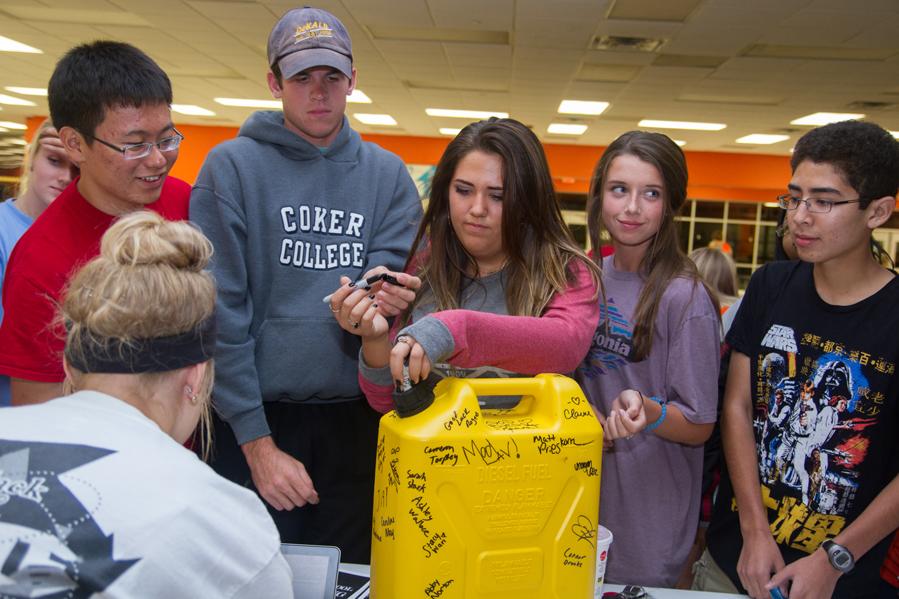Hydrate the cause
Thirst project visits Student Council
Photo by Emily Meinzer
October 15, 2015
MeYou wake up. You take a shower. Brush your teeth. Flush the toilet. Wash your hands. Get a glass of water. Water the lawn. Start the dishwasher. Do a load of laundry.
The average American uses about 100 gallons of water a day. Imagine having to walk more than 3 miles from your home to collect just 5 gallons water that isn’t even safe to drink.
Thirst Project is a non-profit organization that uses 100 percent of the funds collected to provide water wells for underdeveloped countries. Representatives Madeline Lavery and Janani Muthaiya, also called Road Warriors, gave a free presentation on the program at the StuCo meeting Oct. 12. StuCo received this visit through their involvement in Texas Association of Student Councils.
According to the Thirst Project website, over 600 million people in the world go without safe, clean drinking water. Dehydration is not the only consequence of an inadequate water source. The time consuming process prevents women from getting jobs and children from getting an education. These water sources are unprotected and used by insects and animals causing an average of one child to die of water-related diseases every 19 seconds.
Road Warriors visit different schools and organizations to spread the word about the program. These young adults travel across the country meeting with at least one school a day.
“It has been amazing,” Lavery said. “First off, I’ve made so many new friends and love every single person I work with. It also is the first time I’ve had to live on my own. I just graduated from high school [in 2015]. Being a road warrior is the best decision I have ever made. It has affected my patience, my communication skills, my public speaking skills, and even my passion. I feel very strong about Thirst Project.”
Thirst Project is the world’s leading youth water activism organization. Middle schools, high schools and colleges across the country have gotten involved and are working to help end the water crisis and contribute to the cause in their own way.
“Without students, we would be a completely different company,” Lavery said. “We need students to be the world changers because students are the future. We need to spread awareness. We need more people talking about the global water crisis and more people who are passionate and want to get involved.”
Thirst Project’s presentation impacted students and sparked planning in their minds.
“I really enjoyed their presentation,” Key Club President and junior John Debenport said. “It’s a great thing for us to do because it lets us get involved in something that’s not just local. It’s a broad cause that helps Texas High make a bigger impact. I think StuCo can definitely take a strong leadership role in this, and Key Club will join. Hopefully Key Club will also do a couple of fundraisers also.”
Ultimately, the goal of Thirst Project is to end the global water crisis. But the organization has a more specific, shorter-term goal as well: give the entire nation of Swaziland safe drinking water by 2022.
“Swaziland has the highest HIV/AIDS population density in the world,” Lavery said. “Even if people have access to medical treatment, the bacteria and parasites in the dirty water [they are drinking] will kill them faster than their AIDS because their immune system is already so compromised. [Reaching our goal] is going to cost us $50 million, but by doing this we can use Swaziland as a case study to show to the United Nations and other water organizations so they can see the drastic change and help implicate [the water wells] everywhere.”
The goals and achievements of Thirst Project has inspired students to believe that they are capable of making a difference despite their age or position in life.
“I thought they were really inspirational,” junior Emily Meinzer said. “It was really neat to hear them talk about how just a dollar can be put to use in a way that can impact someone’s life forever. It definitely opened my eyes and made me realize that I can make a difference. Some of them were fresh out of high school, so it’s not like you have to have a degree to do something big like that.”
Thirst Project’s goal for ending the water crisis is about more than just drinkable water. Giving a community a clean water source improves economic development, food security, health and education rates.
“Water changes every single sector of community life and development,” Lavery said. “So by ending the water crisis, you change all of that. Giving people clean water means giving people a future.”
For more information about the cause and getting starting, visit www.thirstproject.org, or email [email protected] or [email protected].
















